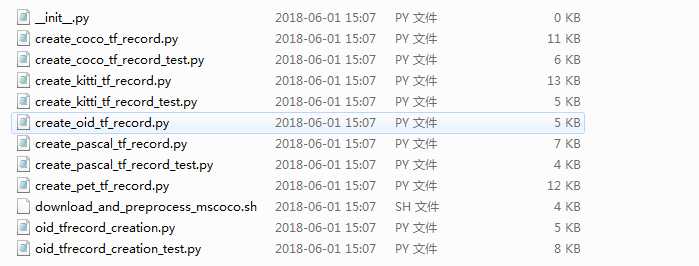标签:hat 信息 时间 fine url multi ref mission number
我们在第三十二节,使用谷歌Object Detection API进行目标检测、训练新的模型(使用VOC 2012数据集)那一节我们介绍了如何使用谷歌Object Detection API进行目标检测,以及如何使用谷歌提供的目标检测模型训练自己的数据。在训练自己的数据集时,主要包括以下几步:

在这里我主要解析一下train.py文件的工作流程。
先附上源码:

# Copyright 2017 The TensorFlow Authors. All Rights Reserved. # # Licensed under the Apache License, Version 2.0 (the "License"); # you may not use this file except in compliance with the License. # You may obtain a copy of the License at # # http://www.apache.org/licenses/LICENSE-2.0 # # Unless required by applicable law or agreed to in writing, software # distributed under the License is distributed on an "AS IS" BASIS, # WITHOUT WARRANTIES OR CONDITIONS OF ANY KIND, either express or implied. # See the License for the specific language governing permissions and # limitations under the License. # ============================================================================== r"""Training executable for detection models. This executable is used to train DetectionModels. There are two ways of configuring the training job: 1) A single pipeline_pb2.TrainEvalPipelineConfig configuration file can be specified by --pipeline_config_path. Example usage: ./train --logtostderr --train_dir=path/to/train_dir --pipeline_config_path=pipeline_config.pbtxt 2) Three configuration files can be provided: a model_pb2.DetectionModel configuration file to define what type of DetectionModel is being trained, an input_reader_pb2.InputReader file to specify what training data will be used and a train_pb2.TrainConfig file to configure training parameters. Example usage: ./train --logtostderr --train_dir=path/to/train_dir --model_config_path=model_config.pbtxt --train_config_path=train_config.pbtxt --input_config_path=train_input_config.pbtxt """ import functools import json import os import tensorflow as tf from object_detection import trainer from object_detection.builders import dataset_builder from object_detection.builders import graph_rewriter_builder from object_detection.builders import model_builder from object_detection.utils import config_util from object_detection.utils import dataset_util tf.logging.set_verbosity(tf.logging.INFO) flags = tf.app.flags flags.DEFINE_string(‘master‘, ‘‘, ‘Name of the TensorFlow master to use.‘) flags.DEFINE_integer(‘task‘, 0, ‘task id‘) flags.DEFINE_integer(‘num_clones‘, 1, ‘Number of clones to deploy per worker.‘) flags.DEFINE_boolean(‘clone_on_cpu‘, False, ‘Force clones to be deployed on CPU. Note that even if ‘ ‘set to False (allowing ops to run on gpu), some ops may ‘ ‘still be run on the CPU if they have no GPU kernel.‘) flags.DEFINE_integer(‘worker_replicas‘, 1, ‘Number of worker+trainer ‘ ‘replicas.‘) flags.DEFINE_integer(‘ps_tasks‘, 0, ‘Number of parameter server tasks. If None, does not use ‘ ‘a parameter server.‘) flags.DEFINE_string(‘train_dir‘, ‘‘, ‘Directory to save the checkpoints and training summaries.‘) flags.DEFINE_string(‘pipeline_config_path‘, ‘‘, ‘Path to a pipeline_pb2.TrainEvalPipelineConfig config ‘ ‘file. If provided, other configs are ignored‘) flags.DEFINE_string(‘train_config_path‘, ‘‘, ‘Path to a train_pb2.TrainConfig config file.‘) flags.DEFINE_string(‘input_config_path‘, ‘‘, ‘Path to an input_reader_pb2.InputReader config file.‘) flags.DEFINE_string(‘model_config_path‘, ‘‘, ‘Path to a model_pb2.DetectionModel config file.‘) FLAGS = flags.FLAGS def main(_): assert FLAGS.train_dir, ‘`train_dir` is missing.‘ if FLAGS.task == 0: tf.gfile.MakeDirs(FLAGS.train_dir) if FLAGS.pipeline_config_path: configs = config_util.get_configs_from_pipeline_file( FLAGS.pipeline_config_path) if FLAGS.task == 0: tf.gfile.Copy(FLAGS.pipeline_config_path, os.path.join(FLAGS.train_dir, ‘pipeline.config‘), overwrite=True) else: configs = config_util.get_configs_from_multiple_files( model_config_path=FLAGS.model_config_path, train_config_path=FLAGS.train_config_path, train_input_config_path=FLAGS.input_config_path) if FLAGS.task == 0: for name, config in [(‘model.config‘, FLAGS.model_config_path), (‘train.config‘, FLAGS.train_config_path), (‘input.config‘, FLAGS.input_config_path)]: tf.gfile.Copy(config, os.path.join(FLAGS.train_dir, name), overwrite=True) model_config = configs[‘model‘] train_config = configs[‘train_config‘] input_config = configs[‘train_input_config‘] model_fn = functools.partial( model_builder.build, model_config=model_config, is_training=True) def get_next(config): return dataset_util.make_initializable_iterator( dataset_builder.build(config)).get_next() create_input_dict_fn = functools.partial(get_next, input_config) env = json.loads(os.environ.get(‘TF_CONFIG‘, ‘{}‘)) cluster_data = env.get(‘cluster‘, None) cluster = tf.train.ClusterSpec(cluster_data) if cluster_data else None task_data = env.get(‘task‘, None) or {‘type‘: ‘master‘, ‘index‘: 0} task_info = type(‘TaskSpec‘, (object,), task_data) # Parameters for a single worker. ps_tasks = 0 worker_replicas = 1 worker_job_name = ‘lonely_worker‘ task = 0 is_chief = True master = ‘‘ if cluster_data and ‘worker‘ in cluster_data: # Number of total worker replicas include "worker"s and the "master". worker_replicas = len(cluster_data[‘worker‘]) + 1 if cluster_data and ‘ps‘ in cluster_data: ps_tasks = len(cluster_data[‘ps‘]) if worker_replicas > 1 and ps_tasks < 1: raise ValueError(‘At least 1 ps task is needed for distributed training.‘) if worker_replicas >= 1 and ps_tasks > 0: # Set up distributed training. server = tf.train.Server(tf.train.ClusterSpec(cluster), protocol=‘grpc‘, job_name=task_info.type, task_index=task_info.index) if task_info.type == ‘ps‘: server.join() return worker_job_name = ‘%s/task:%d‘ % (task_info.type, task_info.index) task = task_info.index is_chief = (task_info.type == ‘master‘) master = server.target graph_rewriter_fn = None if ‘graph_rewriter_config‘ in configs: graph_rewriter_fn = graph_rewriter_builder.build( configs[‘graph_rewriter_config‘], is_training=True) trainer.train( create_input_dict_fn, model_fn, train_config, master, task, FLAGS.num_clones, worker_replicas, FLAGS.clone_on_cpu, ps_tasks, worker_job_name, is_chief, FLAGS.train_dir, graph_hook_fn=graph_rewriter_fn) if __name__ == ‘__main__‘: tf.app.run()
1、先定义了tf.app.flags,用于支持接受命令行传递参数,相当于接受argv。
flags = tf.app.flags flags.DEFINE_string(‘master‘, ‘‘, ‘Name of the TensorFlow master to use.‘) flags.DEFINE_integer(‘task‘, 0, ‘task id‘) flags.DEFINE_integer(‘num_clones‘, 1, ‘Number of clones to deploy per worker.‘) flags.DEFINE_boolean(‘clone_on_cpu‘, False, ‘Force clones to be deployed on CPU. Note that even if ‘ ‘set to False (allowing ops to run on gpu), some ops may ‘ ‘still be run on the CPU if they have no GPU kernel.‘) flags.DEFINE_integer(‘worker_replicas‘, 1, ‘Number of worker+trainer ‘ ‘replicas.‘) flags.DEFINE_integer(‘ps_tasks‘, 0, ‘Number of parameter server tasks. If None, does not use ‘ ‘a parameter server.‘) flags.DEFINE_string(‘train_dir‘, ‘‘, ‘Directory to save the checkpoints and training summaries.‘) flags.DEFINE_string(‘pipeline_config_path‘, ‘‘, ‘Path to a pipeline_pb2.TrainEvalPipelineConfig config ‘ ‘file. If provided, other configs are ignored‘) flags.DEFINE_string(‘train_config_path‘, ‘‘, ‘Path to a train_pb2.TrainConfig config file.‘) flags.DEFINE_string(‘input_config_path‘, ‘‘, ‘Path to an input_reader_pb2.InputReader config file.‘) flags.DEFINE_string(‘model_config_path‘, ‘‘, ‘Path to a model_pb2.DetectionModel config file.‘) FLAGS = flags.FLAGS
这里面有几个比较重要的参数,train_dir目录用于保存训练的模型和日志文件,pipeline_config_path用于指定pipeline_pb2.TrainEvalPipelineConfig配置文件的全路径(如果不指定指定这个参数,需要指定train_config_path,input_config_path,model_config_path配置文件,其实这三个文件就是把pipeline_pb2.TrainEvalPipelineConfig配置文件分成了三部分)。
2、再来看一下main函数,我们把它分成几部分来解读。
假设我们在控制台下的命令如下:
python train.py --train_dir voc/train_dir/ --pipeline_config_path voc/faster_rcnn_inception_resnet_v2_atrous_voc.config
assert FLAGS.train_dir, ‘`train_dir` is missing.‘ if FLAGS.task == 0: tf.gfile.MakeDirs(FLAGS.train_dir) if FLAGS.pipeline_config_path: configs = config_util.get_configs_from_pipeline_file( FLAGS.pipeline_config_path) if FLAGS.task == 0: tf.gfile.Copy(FLAGS.pipeline_config_path, os.path.join(FLAGS.train_dir, ‘pipeline.config‘), overwrite=True) else: configs = config_util.get_configs_from_multiple_files( model_config_path=FLAGS.model_config_path, train_config_path=FLAGS.train_config_path, train_input_config_path=FLAGS.input_config_path) if FLAGS.task == 0: for name, config in [(‘model.config‘, FLAGS.model_config_path), (‘train.config‘, FLAGS.train_config_path), (‘input.config‘, FLAGS.input_config_path)]: tf.gfile.Copy(config, os.path.join(FLAGS.train_dir, name), overwrite=True)
因为我们传入了train_dir,pipeline_config_path参数,程序执行时会:
model_config = configs[‘model‘] train_config = configs[‘train_config‘] input_config = configs[‘train_input_config‘] model_fn = functools.partial( model_builder.build, model_config=model_config, is_training=True) def get_next(config): return dataset_util.make_initializable_iterator( dataset_builder.build(config)).get_next() create_input_dict_fn = functools.partial(get_next, input_config)
第三十四节,目标检测之谷歌Object Detection API源码解析
标签:hat 信息 时间 fine url multi ref mission number
原文地址:https://www.cnblogs.com/zyly/p/9267426.html